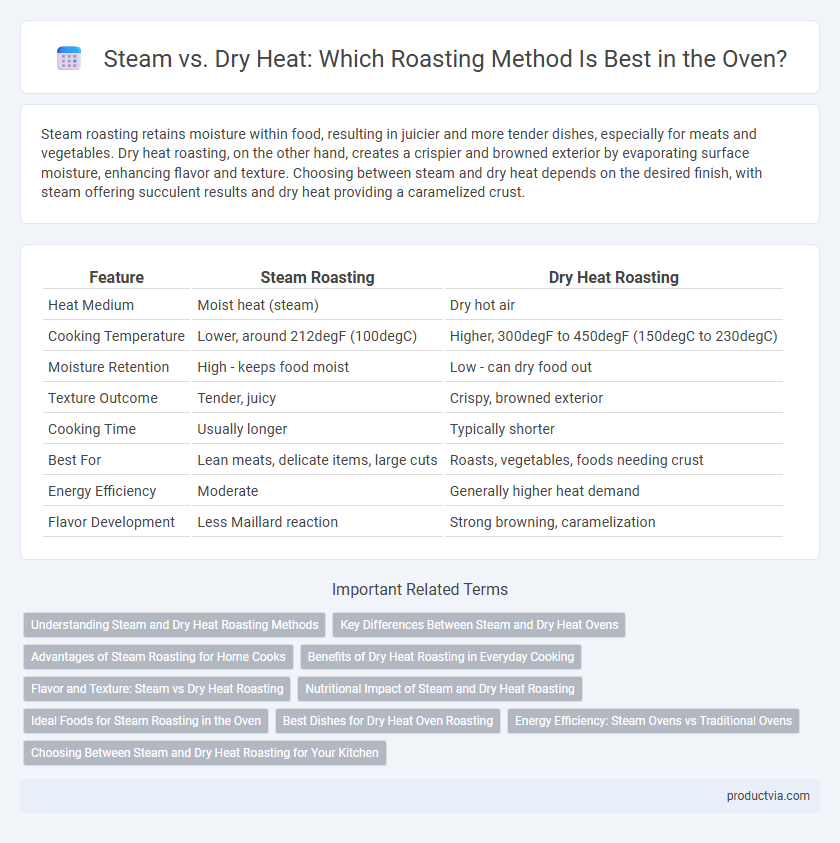Steam roasting retains moisture within food, resulting in juicier and more tender dishes, especially for meats and vegetables. Dry heat roasting, on the other hand, creates a crispier and browned exterior by evaporating surface moisture, enhancing flavor and texture. Choosing between steam and dry heat depends on the desired finish, with steam offering succulent results and dry heat providing a caramelized crust.
Table of Comparison
| Feature | Steam Roasting | Dry Heat Roasting |
|---|---|---|
| Heat Medium | Moist heat (steam) | Dry hot air |
| Cooking Temperature | Lower, around 212degF (100degC) | Higher, 300degF to 450degF (150degC to 230degC) |
| Moisture Retention | High - keeps food moist | Low - can dry food out |
| Texture Outcome | Tender, juicy | Crispy, browned exterior |
| Cooking Time | Usually longer | Typically shorter |
| Best For | Lean meats, delicate items, large cuts | Roasts, vegetables, foods needing crust |
| Energy Efficiency | Moderate | Generally higher heat demand |
| Flavor Development | Less Maillard reaction | Strong browning, caramelization |
Understanding Steam and Dry Heat Roasting Methods
Steam roasting uses moisture to create a humid cooking environment that helps retain food's natural juices, resulting in tender, moist textures and enhanced flavor profiles. Dry heat roasting circulates hot air without added moisture, promoting browning and caramelization for a crisp, flavorful crust. Understanding these methods allows precise control over texture and taste, optimizing culinary results based on the desired outcome.
Key Differences Between Steam and Dry Heat Ovens
Steam ovens use moisture to cook food, resulting in juicier and more tender dishes due to the steam's ability to penetrate and retain natural moisture. Dry heat ovens, such as conventional or convection ovens, rely on hot air circulation that produces a crispy, browned exterior ideal for roasting meats and vegetables. The key difference lies in moisture retention: steam ovens prevent drying out, while dry heat ovens promote caramelization and crust formation.
Advantages of Steam Roasting for Home Cooks
Steam roasting preserves moisture in meats, resulting in juicier, tender dishes that are less prone to drying out compared to dry heat methods. The steam environment helps evenly transfer heat, reducing cooking time and promoting uniform browning without burning. Home cooks benefit from enhanced flavor retention and nutrient preservation, making steam roasting a practical and healthy option.
Benefits of Dry Heat Roasting in Everyday Cooking
Dry heat roasting in ovens maximizes flavor development by promoting caramelization and Maillard browning, enhancing the texture and taste of meats and vegetables. This method allows for even cooking and crisp, golden surfaces without added moisture, resulting in a more desirable crust. Moreover, dry heat roasting reduces cooking time compared to steaming, making it ideal for everyday meal preparation and delivering consistent, rich flavors.
Flavor and Texture: Steam vs Dry Heat Roasting
Steam roasting enhances moisture retention, resulting in juicier and tender meats with a delicate texture, while dry heat roasting creates a crisp, caramelized exterior that intensifies flavor through Maillard reactions. The use of steam helps preserve the natural flavors and prevents drying out during cooking, ideal for lean cuts. Dry heat roasting, by contrast, develops deeper, roasted flavors and a firmer texture, preferred for dishes requiring a robust crust and richer taste.
Nutritional Impact of Steam and Dry Heat Roasting
Steam roasting preserves more vitamins and minerals by reducing nutrient degradation through moisture retention, enhancing the overall nutritional profile of foods like vegetables and lean meats. Dry heat roasting, while promoting flavor through caramelization and Maillard reactions, can lead to greater nutrient loss, especially water-soluble vitamins such as vitamin C and certain B vitamins. Choosing steam roasting can result in higher antioxidant activity and better retention of heat-sensitive nutrients compared to traditional dry heat methods.
Ideal Foods for Steam Roasting in the Oven
Steam roasting in the oven is ideal for foods like poultry, pork, and root vegetables, where moisture retention enhances tenderness and flavor. The steam environment prevents drying and promotes even cooking, making it perfect for large cuts that benefit from slow, gentle heat. Unlike dry heat roasting, steam roasting preserves natural juices while creating a delicate crust, especially suited for whole chickens, briskets, and carrots.
Best Dishes for Dry Heat Oven Roasting
Dry heat oven roasting excels with foods that benefit from caramelization and crispy textures, such as whole chickens, pork roasts, and potatoes. The high, consistent temperature of dry heat promotes Maillard reactions, enhancing flavor and creating a golden-brown exterior. Root vegetables, beef cuts like prime rib, and vegetables like Brussels sprouts also achieve optimal tenderness and a rich, roasted flavor with dry heat roasting techniques.
Energy Efficiency: Steam Ovens vs Traditional Ovens
Steam ovens utilize moisture to cook food at lower temperatures, resulting in faster roasting times and reduced energy consumption compared to traditional dry heat ovens. The presence of steam enhances heat transfer efficiency, minimizing thermal losses and promoting even cooking with less energy input. Studies show steam ovens can reduce energy use by up to 20% during roasting processes compared to conventional dry heat ovens.
Choosing Between Steam and Dry Heat Roasting for Your Kitchen
Steam roasting retains moisture in meats and vegetables, resulting in juicier and tender dishes, ideal for delicate proteins and foods prone to drying out. Dry heat roasting, using high temperatures without added moisture, creates a crispy, caramelized exterior perfect for roasting vegetables, poultry, and meats with thicker cuts. Selecting between steam and dry heat roasting depends on desired texture, moisture retention, and the specific food being prepared in your kitchen.
Steam vs Dry heat for roasting Infographic

 productvia.com
productvia.com